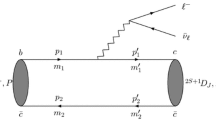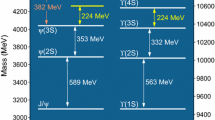Abstract
Widely applied to both light and heavy meson decay and standing as one of the most successful strong decay models is the \(^{3}P_{0}\) model, in which \(q\bar{q}\) pair production is the dominant mechanism. In the present, we use the bound-state corrected version of the \(^{3}P_{0}\), called the C\(^{3}P_{0}\) model, to calculate the decay widths of the charmonium \(J^{PC}=1^{--}\) states, nominally \(J/\psi\), \(\psi (2S)\), \(\psi (3770)\), \(\psi (4040)\), \(\psi (4160)\), \(\psi (4415)\) and \(\psi (4660)\) to several common channels.

Similar content being viewed by others
References
J.J. Aubert et al., Phys. Rev. Lett. 33, 1404 (1974). E598 Collaboration
J.E. Augustin et al., Phys. Rev. Lett. 33, 1406 (1974). SLAC-SP-017 Collaboration
R.M. Baltrusaitis et al., Phys. Rev. D 33, 629–638 (1986)
J.E. Gaiser et al., Phys. Rev. D 34, 711–721 (1986)
S. Godfrey, S.L. Olsen, Annu. Rev. Nucl. Part. Sci. 58, 51 (2008)
FAIR-PANDA, The panda experiment at the facility for antiproton and ion research in darmstadt (fair). https://panda.gsi.de/ (2020)
R.M. Albuquerque, M. Nielsen, R.R. da Silva, Phys. Rev. D 84(2011)
L. Maiani, F. Piccinini, A.D. Polosa, V. Riquer, Phys. Rev. D 89(2014)
D. Ebert, R.N. Faustov, V.O. Galkin, Eur. Phys. J. C 58, 399 (2008)
F.K. Guo, C. Hanhart, U.G. Meißner, Phys. Lett. B 665, 26 (2008)
W. Zhi-Gang, Z. Xiao-Hong, Commun. Theor. Phys. 54, 323 (2010)
P. Guo, A.P. Szczepaniak, G. Galata, A. Vassallo, E. Santopinto, Phys. Rev. D 78(2008)
P.A. Zyla et al., Prog. Theor. Exp. Phys. 2020, 083C01 (2020). PDG - Particle Data Group
D. Hadjimichef, G. Krein, S. Szpigel, J.S. da Veiga, Ann. Phys. 268, 105 (1998)
D.T. da Silva, M.L.L. da Silva, J.N. de Quadros, D. Hadjimichef, Phys. Rev. D 78(2008)
D. Hadjimichef, G. Krein, S. Szpigel, J.S. da Veiga, Phys. Lett. B 367, 317 (1996)
E.S. Ackleh, T. Barnes, E.S. Swanson, Phys. Rev. D 54, 6811 (1996)
S. Okubo, Phys. Lett. 5, 165 (1963)
G. Zweig, CERN Preprints TH-401 (1964)
G. Zweig, CERN Preprints TH-412 (1964)
J. Iizuka, Prog. Theor. Phys. Suppl. 37/38, 21 (1966)
T. Feldmann, P. Kroll, Phys. Rev. D 62(2000)
T. Feldmann, P. Kroll, B. Stech, Phys. Rev. D 58(1998)
B. Aubert et al., Phys. Rev. D 79, 092001 (2009). BABAR Collaboration
A.L. Yaouanc, L. Oliver, O. Pene, J.C. Raynal, Phys. Lett. B 71, 397 (1977)
A.L. Yaouanc, L. Oliver, O. Pene, J.C. Raynal, Phys. Lett. B 72, 57 (1977)
T. Barnes, S. Godfrey, E.S. Swanson, Phys. Rev. D 72(2005)
Author information
Authors and Affiliations
Corresponding author
Ethics declarations
Conflict of Interest
The authors declare no competing interests.
Additional information
Publisher's Note
Springer Nature remains neutral with regard to jurisdictional claims in published maps and institutional affiliations.
Appendix. Parameters
Appendix. Parameters
After the simulation the best \(J/\psi\) fit to the experimental data is achieved with \(\gamma =0.33\), \(\beta _{J/\psi }= 0.182\) GeV, \(\beta _\rho =0.55\) GeV, \(\beta _\pi = 0.55\) GeV, \(\beta _\omega = 0.328\) GeV, \(\beta _{\eta }= 0.348\) GeV, \(\beta _{\eta ^\prime }= 0.170\) GeV, \(\beta _K= 0.4\) GeV, \(\beta _{K^*}=0.315\) GeV, \(\beta _{\phi }=0.340\) GeV, \(\beta _{\phi _\Delta }=0.3\) GeV, \(\beta _{\omega _\Delta }=0.6\) GeV and \(\beta _{J/\psi _\Delta }=0.3\) GeV. These results and the experimental values are shown in the left part of Table 2.
The best \(\psi (2S)\) fit to the experimental data is achieved with \(\gamma =0.33\), \(\beta _{\psi }= 0.042\) GeV, \(\beta _\rho =0.55\) GeV, \(\beta _\pi = 0.55\) GeV, \(\beta _\omega = 0.7\) GeV, \(\beta _{\eta }= 0.7\) GeV, \(\beta _{\eta ^\prime }= 0.8\) GeV, \(\beta _K= 0.47\) GeV, \(\beta _{K^*}=0.8\) GeV, \(\beta _{\phi }=0.7\) GeV, \(\beta _{\phi _\Delta }=0.9\) GeV, \(\beta _{\omega _\Delta }=0.6\) GeV and \(\beta _{\psi _\Delta }=0.042\) GeV. These results and the experimental values are shown in the right part of Table 2.
The best \(\psi (3770)\) is \(\beta _{\psi (3770)} = 0.9\) GeV, \(\gamma =0.33\), \(\beta _\rho =0.105\) GeV, \(\beta _\pi = 0.86\) GeV, \(\beta _\omega = 0.22\) GeV, \(\beta _{\eta }= 0.7\) GeV, \(\beta _{\eta ^\prime }= 0.9\) GeV, \(\beta _K= 0.8\) GeV, \(\beta _{K^*}=0.175\) GeV, \(\beta _{\phi }=0.65\) GeV, \(\beta _{\phi _\Delta }=0.9\) GeV, \(\beta _{\omega _\Delta }=0.6\) GeV and \(\beta _{\psi _\Delta }=0.2\) GeV.
For the D channels a minor modification is observed in the parameters \(\beta _{\psi (3770)} = \beta _{\psi (4040)} = \beta _{\psi (4160)} = \beta _{\psi (4415)} = \beta _{\psi (4660)} = 0.5\) GeV and \(\beta _{D^*}=0.2\) GeV, \(\beta _D=0.6\) GeV, \(\beta _{D^{0\,*}}=\beta _{D^0}= 0.51\) GeV, \(\beta _{D_s} = \beta _{D^*_s} =0.53\) GeV ; \(\beta _{\phi _\Delta }=0.9\) GeV, \(\beta _{\omega _\Delta }=0.6\) GeV and \(\beta _{\psi _\Delta }=0.2\) GeV.
Rights and permissions
Springer Nature or its licensor (e.g. a society or other partner) holds exclusive rights to this article under a publishing agreement with the author(s) or other rightsholder(s); author self-archiving of the accepted manuscript version of this article is solely governed by the terms of such publishing agreement and applicable law.
About this article
Cite this article
Hameed, A.A., Hassan, G.S., da Silva, D.T. et al. Charmonium JPC = 1–– Decay in the C3P0 Model. Braz J Phys 53, 27 (2023). https://doi.org/10.1007/s13538-022-01233-1
Received:
Accepted:
Published:
DOI: https://doi.org/10.1007/s13538-022-01233-1




